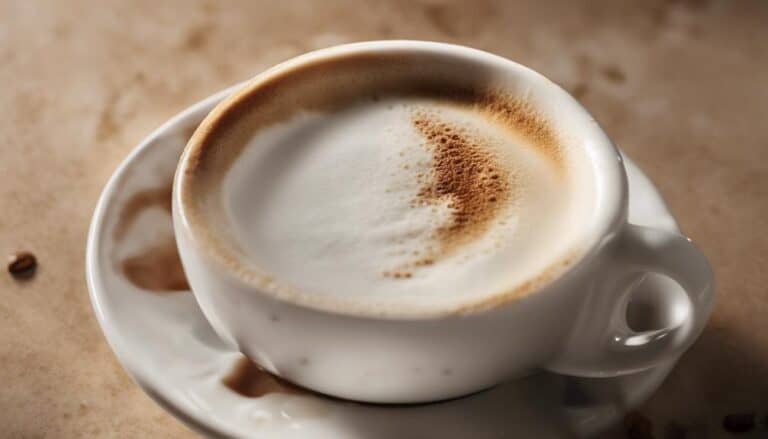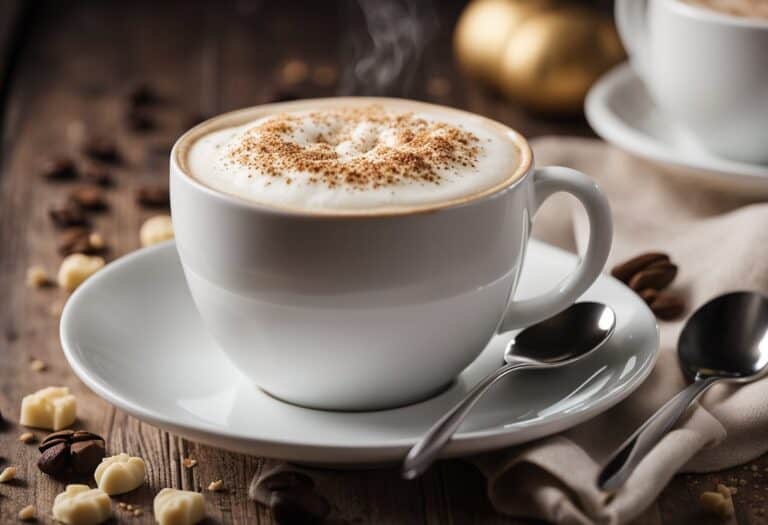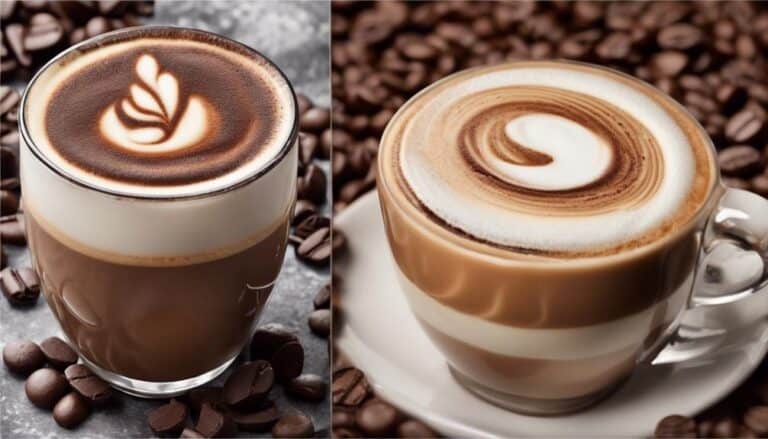Cappuccino vs Flat White: What’s the Difference?

Cappuccino and flat white are two popular coffee drinks that are often confused with each other. They are both espresso-based drinks that use steamed milk, but the way they are prepared and served is different. In this article, we will explore the differences between cappuccino and flat white, so you can make an informed decision the next time you visit a coffee shop.
Understanding the basics of cappuccino and flat white is essential to appreciate the differences between them. Cappuccino is made with equal parts of espresso, steamed milk, and frothed milk. The layers of espresso, milk, and froth give the drink a distinct appearance, with the frothed milk forming a layer on top. On the other hand, flat white is made with less milk than cappuccino and has a velvety texture. It is made with a double shot of espresso and steamed milk, with a thin layer of microfoam on top.
Origin and history of these drinks are also interesting topics to explore. Cappuccino is believed to have originated in Italy in the 1900s, while flat white is said to have originated in Australia or New Zealand in the 1980s. Both drinks have gained popularity around the world and are now available in most coffee shops. Now let’s dive deeper into the differences between cappuccino and flat white.
Key Takeaways
- Cappuccino and flat white are two popular espresso-based drinks that use steamed milk, but they are prepared and served differently.
- Cappuccino is made with equal parts of espresso, steamed milk, and frothed milk, while flat white is made with less milk and has a velvety texture.
- The origin and history of these drinks are interesting to explore, but understanding the differences between them is essential to make an informed decision.
Understanding the Basics
When it comes to coffee drinks, cappuccino and flat white are two of the most popular choices, but what are the differences between them? In this section, we’ll go over the basics of cappuccino and flat white to help you understand the key factors that set them apart.
Espresso
Both cappuccino and flat white are made with espresso, which is a type of coffee that is brewed by forcing hot water through finely ground coffee beans. Espresso is the base of many coffee drinks and is known for its strong, bold flavor.
Milk
One of the main differences between cappuccino and flat white is the way that milk is prepared and used in the drink. Cappuccino is typically made with equal parts espresso, steamed milk, and foam. The foam is created by aerating the milk with steam from an espresso machine. Flat white, on the other hand, is made with less foam and more steamed milk, resulting in a smoother texture.
Size
Another difference between cappuccino and flat white is the size of the drink. Cappuccino is typically served in a smaller cup, ranging from 5 to 6 ounces, while flat white is served in a larger cup, ranging from 8 to 12 ounces. The larger size of the flat white allows for more milk and espresso, resulting in a stronger flavor and a creamier texture.
Specialty Coffee Shops
If you’re a coffee lover, you may be interested in trying cappuccino and flat white at a specialty coffee shop. These shops often use high-quality coffee beans and offer a variety of brewing methods to create unique and flavorful drinks. Some popular specialty coffee shops include Starbucks, Blue Bottle Coffee, and Stumptown Coffee Roasters.
In conclusion, cappuccino and flat white are two popular coffee drinks that are made with espresso and milk, but differ in the way that milk is prepared and used in the drink, as well as the size of the cup. Whether you prefer a strong, bold flavor or a smoother, creamier texture, there’s a coffee drink out there for every coffee lover to enjoy.
Origin and History
Cappuccino and Flat White are two of the most popular coffee drinks around the world. Both drinks have their own unique characteristics that make them stand out from each other. In this section, we will explore the origin and history of both beverages.
The history of cappuccino can be traced back to Italy, where it was first introduced in the early 1900s. The drink was named after the Capuchin monks, who wore brown robes that resembled the color of the coffee. The first cappuccino was made by combining espresso, steamed milk, and milk foam. Over time, the drink became popular all over the world, and today, it is one of the most commonly ordered coffee drinks.
Flat White, on the other hand, has a more disputed origin. According to some sources, the drink was first invented in Sydney, Australia, in the 1980s. However, others claim that the drink was actually invented in Wellington, New Zealand, in the late 1980s. Regardless of its origin, the flat white is a popular drink in both Australia and New Zealand.
The name “flat white” is believed to have originated from the way the milk is steamed. Unlike cappuccino, which has a thick layer of milk foam on top, flat white has a thin layer of velvety milk on top of the espresso shot. The milk is steamed in a way that creates a microfoam, which gives the drink a smooth and creamy texture.
In summary, cappuccino originated in Italy and was named after the Capuchin monks. Flat White’s origins are disputed, with both Australia and New Zealand claiming to be the birthplace of the drink. The name “flat white” comes from the way the milk is steamed, creating a velvety layer of milk on top of the espresso shot.
Cappuccino
Cappuccino is one of the most popular espresso drinks around the world. It originated in Italy and is made with equal parts of espresso, steamed milk, and frothed milk. The name “cappuccino” comes from the Capuchin friars, who wore brown robes with hoods that resembled the drink’s color and shape.
Cappuccino is known for its creamy texture and velvety smooth mouthfeel. The frothed milk creates a dry foam layer on top of the drink, which is often decorated with latte art. The drink is usually served in a small cup, with a serving size of around 6-8 ounces.
Cappuccino has a strong espresso flavor, balanced by the sweetness of the steamed milk. The milk foam helps to mellow out the intensity of the espresso, creating a bold taste that is still creamy and smooth. The ratios of espresso to milk can vary depending on the barista and the region, but a typical cappuccino has a higher espresso-to-milk ratio than a latte.
Cappuccino can be flavored with a variety of syrups, sweeteners, and spices such as cinnamon or cocoa powder. Some people prefer to add whipped cream on top of their cappuccino for an extra creamy texture and sweeter flavor. However, this is not a traditional way to serve cappuccino.
In terms of caffeine content and calorie content, cappuccino falls somewhere in the middle of the espresso drink spectrum. The milk content and frothed milk can affect the calorie count, but a typical cappuccino has around 80-120 calories and 80-120 mg of caffeine.
Overall, cappuccino is a classic espresso drink that is loved by many for its bold taste and creamy texture. Its history and tradition make it a staple in coffee culture worldwide.
Flat White
Flat white is a popular espresso-based drink that originated in Australia and New Zealand. It is made with a double shot of espresso and steamed milk, with a velvety texture and a creamy mouthfeel. The milk used in a flat white is frothed to create microfoam, which is a silky and smooth texture that blends well with the espresso.
The milk-to-coffee ratio in a flat white is different from that of a latte or cappuccino. A flat white has a higher proportion of coffee to milk than a latte, but less milk foam than a cappuccino. The ratio of milk to espresso in a flat white is usually 1:2, which means that there is twice as much espresso as milk in the drink.
The size of a flat white is typically smaller than that of a latte or cappuccino, with a serving size of around 5-6 ounces. However, the exact size can vary depending on the coffee shop and the barista’s personal preference.
When it comes to milk preparation, whole milk is typically used for a flat white, although some coffee shops may offer skim milk or other milk alternatives. The milk is frothed and steamed to create a micro-foam texture, which gives the drink its velvety smooth mouthfeel.
In terms of flavor, a flat white has a milder espresso flavor compared to a cappuccino or a long black. It is a rich and smooth drink that is perfect for coffee lovers who enjoy a creamy texture without the intensity of a straight espresso shot.
When it comes to nutrition, a flat white typically has a lower calorie content compared to other espresso drinks, such as lattes or mochas. However, the exact calorie intake can vary depending on the milk content and any added flavoring or sweetener.
Overall, a flat white is a specialty coffee drink that is perfect for those who enjoy a rich and creamy texture with a mellow espresso flavor. It is a popular choice among coffee lovers in Australia and New Zealand, and has gained popularity in coffee shops around the world, including Starbucks.
Comparing Cappuccino and Flat White
When it comes to espresso drinks, cappuccino and flat white are two popular options. While they may seem similar at first glance, there are a few key differences that set them apart.
One of the main differences between cappuccino and flat white is the milk-to-coffee ratio. A traditional cappuccino is made with equal parts espresso, steamed milk, and foam, while a flat white has more milk and less foam. This means that a flat white has a creamier, velvety texture, while a cappuccino has a drier, frothier mouthfeel.
Another difference is the serving size. A cappuccino is typically served in a smaller cup, around 5-6 ounces, while a flat white is usually served in a larger cup, around 8-10 ounces. This means that a flat white has a higher coffee-to-milk ratio, while a cappuccino has a higher milk-to-coffee ratio.
In terms of taste, cappuccino has a stronger coffee flavor, while flat white is more balanced and mellow. This is because the extra milk in a flat white helps to soften the intensity of the espresso. However, the exact flavor and balance of each drink can vary depending on personal preference and the specific recipe used.
Overall, the choice between cappuccino and flat white comes down to personal preference. If you prefer a drier, frothier mouthfeel and a stronger coffee flavor, cappuccino may be the way to go. If you prefer a creamier texture and a more balanced taste, flat white may be more your style.
Conclusion
In conclusion, we have learned that there are some key differences between cappuccino and flat white. The main difference lies in the milk-to-coffee ratio and milk texture. Cappuccinos have a higher milk-to-coffee ratio and a thicker, creamier texture due to the frothed milk. Flat whites, on the other hand, have a lower milk-to-coffee ratio and a smoother, velvety texture due to the microfoam milk.
When it comes to taste, the difference is subtle but noticeable. Cappuccinos have a stronger coffee flavor and a sweeter taste due to the frothed milk. Flat whites have a milder coffee flavor and a slightly nutty taste due to the microfoam milk.
In terms of size, cappuccinos are typically larger than flat whites. A traditional cappuccino is usually 6-ounce, while a flat white is usually 5-ounce. However, this can vary depending on the coffee shop.
Ultimately, the choice between cappuccino and flat white comes down to personal preference. If you prefer a stronger coffee flavor and a creamier texture, then cappuccino might be the right choice for you. If you prefer a milder coffee flavor and a smoother texture, then flat white might be the better choice.
It’s important to note that there is no right or wrong choice between cappuccino and flat white. Both are delicious and popular coffee drinks that are enjoyed by coffee lovers all over the world.





